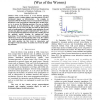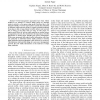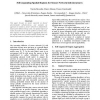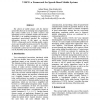BROADNETS
2007
IEEE
14 years 5 months ago
2007
IEEE
Abstract— Overlay networks achieve new functionality and enhance network performance by allowing routing to be controlled at the application layer. However, these approaches resu...
BROADNETS
2007
IEEE
14 years 5 months ago
2007
IEEE
—“War of the worms” is a war between opposing computer worms, creating complex worm interactions as well as detrimental impact on infrastructure. For example, in September 20...
BROADNETS
2007
IEEE
14 years 5 months ago
2007
IEEE
BROADNETS
2007
IEEE
14 years 5 months ago
2007
IEEE
— Power-management approaches have been widely studied in an attempt to conserve idling energy by allowing nodes to switch to a low-power sleep mode. However, due to the inherent...
BROADNETS
2007
IEEE
14 years 5 months ago
2007
IEEE
—Grid computing aims to realize a high-performance computing environment, while increasing the usage efficiency of installed resources. This puts considerable constraints on the...
AINA
2007
IEEE
14 years 5 months ago
2007
IEEE
This paper focuses on sensor networks as shared environmental infrastructures, and presents an approach to enable a sensor network to self-partition itself, at pre-defined energy ...
AINA
2007
IEEE
14 years 5 months ago
2007
IEEE
This paper presents an architectural model for contextual-based delegation access control for pervasive computing, particularly access control mechanisms for ad hoc coalition scen...
AINA
2007
IEEE
14 years 5 months ago
2007
IEEE
The advent of mobile phones and the Internet opened the doors for an emerging class of applications that connect mobile users to online resources and information services availabl...
AINA
2007
IEEE
14 years 5 months ago
2007
IEEE
In recent years, several trust and reputation models have been proposed to enhance the security of mobile ad hoc networks. However, they either fail to capture evidence of trustwo...
AINA
2007
IEEE
14 years 5 months ago
2007
IEEE
— This paper presents a computing model for resource-limited mobile devices that might be ubiquitously deployed in private and business environments. The model integrates a stron...




